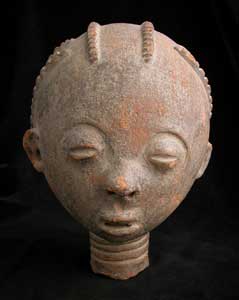Asante Terracotta Funerary Head, 17th Century CE - 19th Century CE
Terracotta
6.375 x 10
PF.3902
Further images
Excavated at Ahinsan, in the southern region of Ghana inhabited by the Asante tribe (also spelled Ashanti), this terracotta head dates from the 17th to the 18th century. The famous...
Excavated at Ahinsan, in the southern region of Ghana inhabited by the Asante tribe (also spelled Ashanti), this terracotta head dates from the 17th to the 18th century.
The famous ethnologist R. S. Rattray, who studied the Asante extensively, recorded the legend, “a woman potter had become sterile after having modeled figures for a pottery shrine.” The ceremonial and funerary pottery was therefore made by men.
Busts, such as this one, were attached to the lids of the family pottery funerary shrines reserved for the worship of the female principal “Abusua.” These sculptures were discovered partially buried, abandoned in ancient places of worship outside the village. According to inhabitants, they are “ancestor portraits.” Terracotta statuary seems to have been eclipsed by the extraordinary development of goldsmith work. In turn, these works in gold became the repositories of the supernatural forces of the deceased, and the terracotta portraits laid forgotten until this century.
The famous ethnologist R. S. Rattray, who studied the Asante extensively, recorded the legend, “a woman potter had become sterile after having modeled figures for a pottery shrine.” The ceremonial and funerary pottery was therefore made by men.
Busts, such as this one, were attached to the lids of the family pottery funerary shrines reserved for the worship of the female principal “Abusua.” These sculptures were discovered partially buried, abandoned in ancient places of worship outside the village. According to inhabitants, they are “ancestor portraits.” Terracotta statuary seems to have been eclipsed by the extraordinary development of goldsmith work. In turn, these works in gold became the repositories of the supernatural forces of the deceased, and the terracotta portraits laid forgotten until this century.







